 Technical Archives
Technical Archives

 Technical Archives
Technical Archives
This page was last updated on $Date: 2001/12/11 00:02:02 $.
This month we deal with the overdrive unit, looking at in-car repairs and tweaks, some of which never before appeared in print. This article is written from over thirty years experience repairing overdrives and is my personal observations and some sections may not agree with popular opinions.
Many articles have been written about maintenance and repair of the overdrive unit. This article is meant to supplement what has already been written and not cover the information available in repair manuals or other tech articles.
The overdrive unit is a very dependable unit, able to function over a period of ten or fifteen years and 100,000 miles of normal driving with no more than a switch and solenoid replacement and adjustment of the valve setting lever. As strong as it is, the overdrive unit is still the weak link in the Healey drive train. In a season of weekly hill climbs and autocrossing, you can expect to destroy two or three overdrive units.
For the vast majority of Healey owners, driving one or two thousand miles a year and autocrossing two or three times a year, the overdrive should last at least ten years - not bad overall. When it does fail, it won't be a catastrophic failure as it usually is from all-out racing.
Let's start with the basic overdrive problem - the OD unit does not engage. Check the oil level and top off if necessary. I use straight weight (no multi-viscosity) 40 weight non-detergent oil. The original Healey manual recommends 20/40, 20/50, or thereabouts for summer driving. Triumph TR3's and TR4 '5 use the identical OD unit and their manual recommends 80/90 weight hypoid oil - go figure.
If the oil level is satisfactory, remove the metal/fiberglass gearbox cover, then energize the solenoid to see if the solenoid is operating. NOTE: If the solenoid does not function, follow instructions in the factory manual to trace wiring and/or switches. If the solenoid is moving the valve setting lever (located on the opposite side of the OD unit from the solenoid), the next step is to adjust the operating valve using this lever (see Fig 6.17 and 6.16).
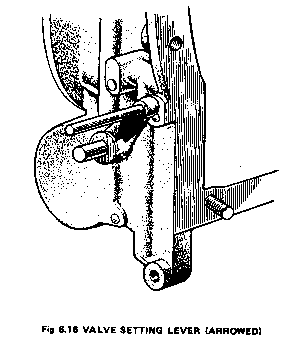
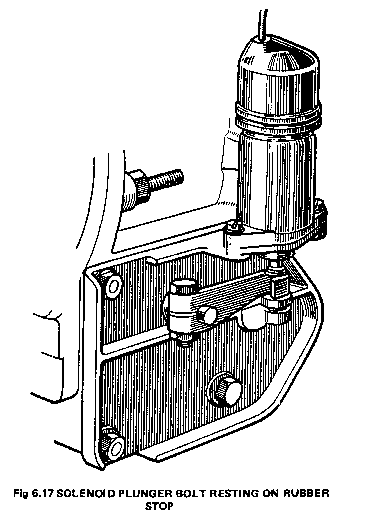
The manual describes how to adjust the valve setting lever by energizing the solenoid, inserting a 3/16 inch diameter rod into the lever and adjusting the control mechanism (a clamp on a shaft passing through the OD unit) until the 3/16 inch rod slips into a hole in the OD casing. When the rod passes into the hole in the OD casing, the operating lever will lift a ball 1/32 inch off its seat. THIS DOES NOT WORK!!!
There are simply too many parts involved in this Rube Goldberg design to accurately lift the operating valve the correct distance, especially with 30 or more years of wear. The OD currently in my car does not function if the valve setting lever is set as described in the factory manual.
The only function of the solenoid, plunger, shaft clamp, rod valve setting lever, and operating valve is to lift a ball in the operating valve chamber 1/32 inch to allow oil under pressure from the accumulating piston to flow to the two operating cylinders which move the pistons forward to engage the overdrive clutch. Rather than using the hole in the valve setting lever as an alignment device and assume that the ball is lifted the correct amount, we will set the OD solenoid adjustment by observing the ball and adjusting the solenoid directly from the movement of the ball.
Before we adjust the valve setting lever, let's find out how close the setting was before we adjust it correctly. Using the working end of a 3/16 inch diameter drill bit, clean out the hole in the valve setting lever and the hole in the OD casing from years of crud and road grime. Then energize the solenoid and place the smooth end of the drill bit into the valve setting lever until the drill bit either bottoms out on the OD unit or slips into the hole in the OD unit (Be careful you don't rotate the lever and get a false reading - you can override the solenoid). Put enough pressure on the drill bit so that when you de-energize the solenoid, the valve setting lever does not move. If the drill bit slips into the hole with the solenoid energized, this is the correct factory setting but possibly not the setting we need. If the drill bit bottoms out on the OD casing, de-energize the solenoid, and using the drill bit as a handle, rotate the valve setting lever toward the hole in the OD casing to get an idea of how far away the drill bit is from the hole in the casing. De-energize and energize the solenoid as many times as it takes to know the relative location of the hole in the valve setting lever to the hole in the OD casing.
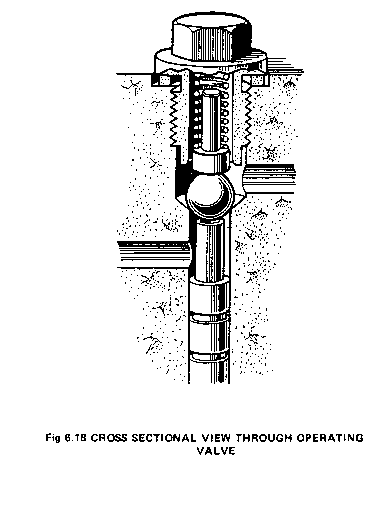
Now let's actually set the adjustment(See Fig 6-18). Remove the operating valve plug, valve spring and ball valve plunger, leaving the ball (or ball valve as it's called in the manual) and operating valve in their normal position. Loosen the solenoid lever clamp (under the solenoid) so you can freely move the valve setting lever. (Note: This lever will now rotate 360 degrees and if it does, the operating valve inside the OD will slip into the bowels of the unit. If this happens to you too (yes, I've done it), remove the ball, then insert a small round screwdriver or stiff wire into the hole in the operating valve and lift the valve from the unit. Rotate the valve setting lever to its approximate correct position and lower the operating valve to its normal position and replace the ball). Rotate the valve setting lever toward the hole in the OD casing. As you approach the vicinity of the hole in the OD casing, you will see the ball beginning to lift. Rotate the valve setting lever until the ball lifts at least 1/32 inch, but less than 1/16 inch. I split the difference and set mine at 3/64 inch lift. Now retighten the solenoid lever clamp (under the solenoid). Energize and de-energize the solenoid (put your finger over the ball when you energize or you'll get a surprise), verifying that the ball lifts 3/64 inch off its seat. Do this until you are positive that the adjustment is correct.
Replace the ball valve plunger, valve spring, and operating valve plug. Energize the solenoid - now compare the location of the valve setting lever to the original setting you took earlier. If the two settings are 1/32 inch apart, this is enough of a difference to cause the OD not to engage. Just for heck of it, see how close the new setting is to lining up the hole in the valve setting lever with the hole in the OD.
No, we're not ready to test drive yet. We have to check the most overlooked part of the OD system - the actual hydraulic pressure in the accumulator/operating valve chambers. DO NOT BYPASS THIS SECTION - IT IS RARELY CHECKED AND IS EXTREMELY IMPORTANT TO THE OPERATION OF THE OD UNIT. According to the factory manual, a working oil pressure of 470 to 490 pounds per square inch (psi) is required. However, the OD will engage at approximately 100 psi for a short period. The hotter the oil, the shorter the period. This is the main cause of slow- to-activate OD's or one that cuts out once it gets fully heated up under use - a very common problem today. The fix is relatively simple, but can be diagnosed only with a pressure gage.
In the 1970's, I spent an entire summer trying to solve an intermittent OD problem. After removing the OD six times, I broke down and purchased a pressure gage. My pressure was just over 100 psi and the OD would work with the car up on jack stands, but rarely on the road. I replaced the OD pump and noticed no change. The problem - you'll have to read on. I did learn something else - by removing the rear motor mounts and jacking up the transmission, the OD can be removed and replaced without removing the transmission. In fact, I find it easier to assemble than on a bench.
Back to the gage. I recommend a 0-100 psi liquid-filled (glycerine) oil pressure gage with a 1/4NPT male fitting. The liquid filled gage is necesary to keep the indicating needle from vibrating, so you can get an accurate reading. You also need a spare OD operating valve plug and a 1/4NPT steel pipe coupling. Drill a 1/16 inch diameter hole thru the operating valve plug, then braze the hex portion of the plug to the coupling. Now screw the gage into the coupling. This is not expensive and not a whole lot of work, but will quickly become your favorite tool, well maybe your second favorite tool.
Now it's time to get serious. Your Healey should be up on jack stands, the gearbox cover removed, and the valve setting lever set perfectly to raise the operating valve ball 3/64 inch up off its seat when the OD solenoid is energized. Remove the operating valve plug from the OD and screw in the operating valve plug that has the pressure gage attached. Use vise grips on the steel coupling to tighten.
Start the engine in neutral and adjust the idle to about 1500 rpm. Without feeding any gas, place the gearshift into 4th (OD off) gear while watching the gage. The pressure should increase from 0 to 3OOpsi in TWO TO THREE SECONDS. In another 10 seconds, the pressure should have gone from 300 to 47Opsi, where it should remain constant. Keep the car running at 1500 rpm while watching the gage - it should stay rock steady at 470 to 49Opsi.
Now engage OD while watching the gage - it should drop about 100 psi when OD kicks in, then climb back up to 470-490 in about 5 seconds. While watching the gage, place the gearbox into neutral, hit the brakes, turn off the engine. When the rear wheels stop turning, the pressure will drop slowly into the low 400's, then continue dropping at a rate of about lOpsi per minute down to about 250-3OOpsi where it should stay for several hours. These numbers are not absolute, simply my records over the past 30 years. However, they will give you a benchmark of how well your OD hydraulic system is functioning and if further repairs are necessary. If your OD is working as described so far, button it up and enjoy.
If your OD is like most, it won't hit the 47Opsi mark and/or won't maintain the pressure. Relax, the fix is relatively simple and you won't even have to remove the unit from car.
As promised, this month continues with the OD unit, specifically the OD pressure fix. However, before we start with the OD pressure fix, let me re-emphasize the need for an oil pressure gage. If you or someone else rebuilt your OD without the benefit of a pressure gage, there is NO WAY to know the status of your hydraulic system. Remember that the OD unit will engage at only 100 psi, but for proper operation, the pressure should be at 470 to 490 psi.
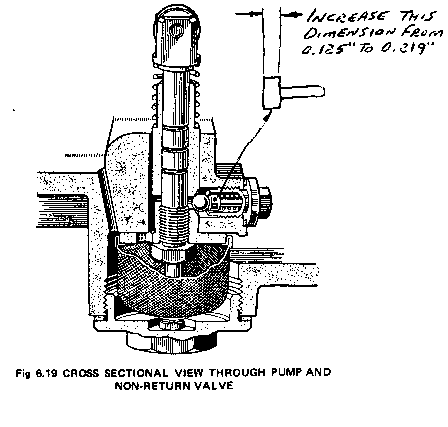
Now, finally... the OD low oil pressure cause and fix. A fatigued spring in the non-return valve portion of the OD (see Fig. 6.19). What? Is that it? You must be kidding - I waited two months for this? Yes, it does seem sort of anti-climactic, but this spring can cause major frustration. Springs are like people - as they age, they get shorter and weaker. As you can see in Fig. 6.19, the spring pushes against a ball and plunger. The purpose of this spring is to allow the ball to lift from its seat at each power stroke of the OD pump, allowing oil to flow into the pressurized accumulating chamber, then applying enough pressure to re-seat the ball at the non-power stroke of the OD pump. A shortened, weakened, fatigued spring does not have enough force to re-seat the ball valve, allowing oil to leak past and cannot build pressure to the required 470-490 psi.
You're probably thinking that all I have to do is replace the spring, right? Yes, that would work for a while, unless you use an incorrect spring that could be too weak, too strong, or too long. I recommend that you pre-load the existing spring by making a new, longer ball valve plunger as shown in the sketch in Fig. 6.19. This longer plunger will increase the preload on the spring by 3/32" - it doesn't sound like much, but its all you need. Don't make it any longer, it could bottom out the spring, not allowing the ball to move off its seat. Use 1040 carbon steel for the material - if you have a friend who works in a machine shop, this is duck soup.
Now for the actual fix. Remove the drain plug from the OD unit (not the gearbox) to drain the oil. Remove the solenoid from its mounting bracket. Now remove the mounting bracket - early model cars have direct access to the mounting screws, later models have a cover. All the 6-cylinders have enough room to remove this bracket with the OD in place, but if my memory is correct, the 4-cylinder Healeys have to raise the OD unit (not remove) to clear the frame. This bracket also pre-loads the OD accumulator spring, so take your time removing the screws and follow the shop manual directions closely. Note that you should have a spacer behind the clamp and a rubber 0-ring sitting in its own counterbore on the back side of the bracket. Since the accumulator spring and distance tube are now loose, remove them from the unit.
You can now see the hex head of the non-return valve plug. Remove this hex head screw using an 11 mm socket. Be aware that these screws are usually VERY tight. Remove the spring, ball valve plunger, and ball. Inspect the ball for wear and inspect the valve seat for dirt and wear. Inspect the OD pump spring to ensure that it is not broken. Turn over the engine with the car in gear while watching the OD pump shaft go up and down. If everything looks good, reseat the ball by tapping it on its seat with a light hammer and drift, reassemble the pump non-return valve using the old spring and the new, longer ball valve plunger.
We're not quite done yet, but if you're like I am and REALLY want to know if the new, longer ball valve plunger solves the OD pressure problem, reassemble the OD and test as described in last months OD tech article. You will probably find that you have 450 to 470 psi showing on the gage. The next section will get it up to 490 psi.
You already should have removed the accumulator spring and distance tube, exposing the piston and sleeve. Remove the piston and sleeve one of two ways. Using a tool that opens when you squeeze the handle (similar to outside diameter retaining ring pliers), grasp the inside diameter of the sleeve (where the distance tube fit) and remove the sleeve with piston by turning and pulling. A pair of needle nose pliers can also be used by forcing the handle open, using the outside of the pliers against the inside diameter of the sleeve. Scratches won't hurt this surface - they can easily be removed prior to reassembly.
If the sleeve and piston are stubborn and refuse to come out, remove the pressure gage, valve spring, ball valve plunger, ball, and operating valve. Now blow air into the chamber and the piston and sleeve should pop right out. I use a bicycle pump with a needle attachment (for footballs, volleyballs, etc.) inserted into the operating valve chamber, cover the hole with a rag, and one or two quick bursts always breaks the piston and sleeve loose.
Push the piston out of the sleeve and inspect the piston for broken rings. I've never seen broken springs, but I'm sure it's happened to someone. Inspect the sleeve for scoring (not the normal scuffing from the metal piston rings. Notice the 0-ring at the front of the sleeve. This is a high durometer (read hard) 0-ring and should be cut to remove. Because of its hardness, it's difficult to replace. If you do not have a replacement 0-ring and your OD pressure was 450 psi after installing the longer ball valve plunger, why worry? Your pressure gage told you that you don't need it and it will tell you when you do. See the possibilities of this tool?
Now to get the pressure to 490 psi. Somewhere, years ago, I read where BMC increased the accumulator spring pressure to raise the pressure in the accumulating chamber from 450 to the 470-490 psi range. What I have noticed in some of the later model OD units, is a flat washer placed in the bottom of the piston. that we just removed. It is my opinion that this is how BMC increased the pressure to 470-490 psi. That is how we will increase our pressure to 490 psi. Check the bottom of the piston for a flat washer. If there is none, place two washers, each 1/16" thick into the bottom of the piston. Again, this doesn't sound like much, but it will make a noticeable difference.
Insert the piston into the sleeve and place the assembly into the OD unit. Insert the distance tube and spring, then complete the assembly paying particular attention to the two hex head screws that must be screwed in together to compress the spring.
Recheck the OD oil pressure, button up everything and enjoy the responsiveness of the like-new OD. This whole process should have taken less than 4 hours from start to finish. Not bad for so much enjoyment. WHAT? You're still not satisfied? You want Overdrive in all 4 gears, and you want to squeal the tires when you shift into Overdrive?
This month we continue with the OD unit - the competition secrets of the 1960's (and today). If you read the past two tech articles on the OD unit, you'll recall that several checks and modifications can be made to the unit without removing it from the car. The following competition modifications can also be made without removing the unit from the car, and can be part of the first two tech articles, all able to be completed in less than 4 hours.
The competition parts consist of two springs and a piston w/rings. If you read The FLASH and CHATTER, you probably noticed advertisements for competition OD parts. What they don't tell you is that these parts are stock Triumph parts. In the first OD tech article I mentioned that Healeys and Triumphs used the same OD unit. However, BMC removed the large piston and springs and replaced them with an aluminum sleeve, smaller piston and spring and a distance tube.
We simply do the opposite - after removing the distance tube, spring, aluminum sleeve and piston, replace all those parts with the new, larger piston and two springs (one spring fits inside the other). Before you install these parts though, be aware of the affect this will have on your driving enjoyment.
The Healey piston is 1.125" in diameter under 49Opsi pressure. When OD is engaged, the force exerted by the piston against the oil (and the two operating cylinders) is 487 pounds (and you thought that the physics classes you took were wasted).
The Triumph piston is 1.750" in diameter and, with the larger springs, now under 6OOpsi pressure. Since you now have a pressure gage, you can verify this. When OD is engaged, the force exerted by the piston against the two operating cylinders jumps to 1443 pounds - about 3 times as much force.
What does this mean to you? If you are driving in competition and engage OD, it will give you goosebumps. If you are driving the car for pleasure and engage OD, it will give you whiplash and possibly a ticket for "laying rubber". When I drive my car on the road, I shift into neutral before engaging OD, so that should give you a clue as to how uncomfortable it is.
If you are crazy enough to increase the pressure with the "competition" parts, you might as well go all the way. There is a switch mounted on the side of the gearbox that allows OD to engage in third and fourth gear only. Bypass, jumper, or hot-wire that switch so you have OD in ALL 4 gears. At an autocross when you shift from 2nd to 2nd OD and back to 2nd again, the psych value alone is worth 1/2 a second against your competition. There is one small drawback though - OD can be engaged in reverse. If this happens, be prepared for EXPENSIVE repairs to both the OD and transmission.
In an autocross, it is a big advantage to have the OD switch mounted on the gearshift knob. "Works-type" gearshift knobs w/OD switch are now available, but you can also use a gearshift knob from a truck that has a two-speed rear axle. Run two wires directly from the OD toggle switch on the dash to the gearshift knob. This also bypasses the OD switch on the gearbox and will also give you OD in all 4 gears.
Also in competition, it is advantageous to have the OD shift from OD to Normal instantly, instead of waiting for the self- synchronization of the OD unit or the throttle switch on the firewall. Simply disconnect the two wires from the throttle switch at "A" as shown in Fig. G.13 and cover the ends with electrical tape. The wires can otherwise be kept in their original location. To quicken the response time of the OD unit to shift from OD to Normal, remove the operating valve (see Part One) and increase the size of the hole in the side of the valve from 1/32" to 3/64".
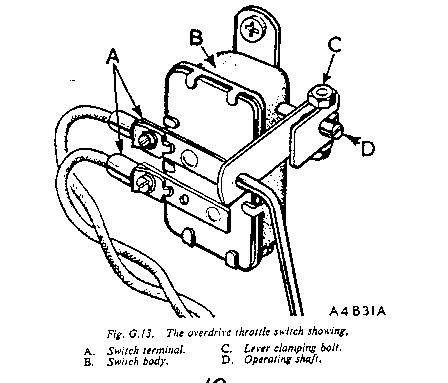
The instant shift from OD to Normal is great when running an autocross but is hard on the transmission and OD. When driving my car on the road, I shift into neutral before disengaging the OD. Something else for you to consider.
Here endith the tweaks and repairs to the OD unit that can be performed wothout removing the unit from the car.
There is one more problem I would like to cover with the OD unit - clutch slip. Yes, the manual lists several causes, but not the ones I've experienced and you will too.
The factory manual lists the following causes:
Except for number 6 above, the previous tech articles have covered all the listed problems. However, this article approaches the problem from a different perspective - clutch slip when driving in Normal, not OD. The clutch that the factory manual and this article refers to is the uni-directional clutch located in the rear housing of the OD unit. See Fig. G.7.
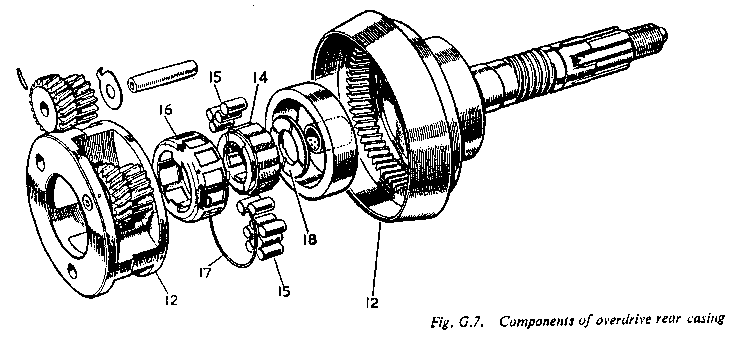
How can you tell when the uni-directional clutch is slipping? When you try to start out smartly from a stop and the engine rpms rise but your car's acceleration doesn't follow, or your car justs sits there. Maybe you're driving in 2nd or 3rd gear and when you quickly step on the gas the engine rpms increase but not your road speed. It can be very subtle or simply leave you sit, or anywhere in between.
Yes, the symptoms are identical to the clutch slip at the engine flywheel, but the damage caused by the uni-directional clutch can ruin both the entire OD unit and transmission.
If you experience the slipping symptoms and you haven't replaced your flywheel clutch in years, remove the transmission w/OD from the car. Remove the pressure plate and inspect the clutch disc for slipping, i.e., burned, glazed surface, or oil covered. If you're convinced that it was this clutch that was slipping, install a new pressure plate, clutch disc, and throw-out bearing then replace the transmission w/OD unless they are due for a rebuild.
However, if the clutch and pressure plate look good or if you're positive they are good, the slipping has to be through the uni-directional clutch in the OD. This requires disassembly of the OD unit. Remember from an earlier tech article that you CAN remove the OD unit from the car without removing the transmission. You can save a lot of time by doing it this way if you're sure that the flywheel clutch is not the one slipping.
Once the OD unit is free from the transmission, follow the directions in the factory manual and separate the rear OD casing from the front OD casing. Lift out the sunwheel assembly to expose the uni-directional clutch. Before removing the clutch, let's perform a simple test. Place two fingers inside the splines of the clutch and attempt to rotate the clutch assembly in a clockwise direction. The clutch should NOT turn in its housing AT ALL. If its does, that's the slipping you've been experiencing. Now attempt to rotate the clutch assembly in a counter-clockwise direction - the clutch should spin freely in its housing. Remember, any attempt to rotate in a clockwise direction should INSTANTLY lock up the clutch.
All this was assuming that you don't have a catastophic failure, i.e., broken, loose cylindrical rollers floating freely in the OD unit. If you do, you probably have hardened steel chips throughout the OD and transmission, which requires a complete disassembly of both units. I personally had several complete OD's destroyed by a clutch failure - it can be expensive.
Remove the clutch assembly by rotating the spline portion in a counter-clockwise direction while pulling it towards you about 1/4". At this point, place a rubber band around the rollers to keep them from falling out. Pull the clutch free from the OD casing. If the rollers did fall out, see the assembly procedure at the end of this article.
Most of the time the problem will be with the pressed steel bearing cage (item #16 - outer casing in Fig. G.7.) not able to rotate in relation to item #14, the ratchet part of the clutch. This can be caused by a number of factors:
After repairing and/or replacing parts as required, assemble the clutch as follows:
Please send comments, additions, and errors for the SOL Healey web pages to Bob Haskell.
[SOL
![]() Web
][
Scions of Lucas
Web
][
Scions of Lucas
![]() Home Page
][
SOL British Car Clubs Page
]
Home Page
][
SOL British Car Clubs Page
]